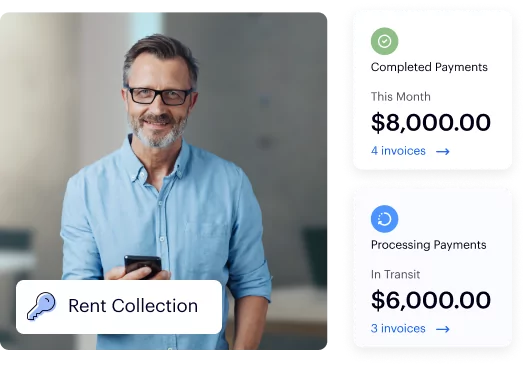If you’re a landlord or property manager, you’re responsible for providing a Certificate of Rent Paid (CRP Certification). Tenants can use this document to claim tax refunds in certain states.
In this article, we’ll walk you through what a CRP is, why it’s important, how to prepare it, and the best way to deliver it to your tenants.
Key takeaways:
- A Certificate of Rent Paid (CRP) shows the total rent a tenant paid in a year.
- Tenants use a CRP rental form to claim tax refunds.
- Landlords must issue CRP certification to tenants by January 31 each year.
- Property taxes must be paid on eligible CRP apartments, mobile homes, condos, and other rentals.
- Simplify rent tracking, invoicing, and CRP preparation with Baselane’s all-in-one rent collection, banking, and bookkeeping platform.
What is a certificate of rent paid (CRP)?
A Certificate of Rent Paid (CRP) is a document landlords give tenants to verify how much rent they paid last year. It generally includes the tenant’s name, address, and the total rent paid.
Unlike a rent receipt for an individual payment, a CRP shows the total amount of rent paid in a tax year. Tenants can use it when filing their taxes to apply for tax refunds or credits.
Here are some state-specific certificate of rent paid refunds:
- Minnesota Renter’s Property Tax Refund (now called the ‘Renter’s Credit’) up to $2,640
- Wisconsin Homestead Credit up to $1,168
- Missouri Property Tax Credit up to $750
- Pennsylvania Property Tax/Rent Rebate Program up to $1,000
Other states with renter tax credits may not require a CRP rental certificate. Eligible renters can receive a portion of the rent they paid as a credit in many states, including Maryland, California, and New York.
When should landlords deliver CRP to renters?
Landlords must give the Certificate of Rent Paid (CRP) to renters by January 31 of each year. Getting CRPs to your tenants promptly ensures they don’t miss any deadlines for tax refunds.
If a renter moves out before December 31, 2024, you have two options: provide the CRP when they move out or wait until the standard deadline of January 31, 2025. If you’re renting to elderly tenants, disabled individuals, or families with dependents, consider sending CRPs earlier so they can claim their benefits.
It’s helpful to collect unpaid rent or rely on rent guarantee insurance to cover missing payments before January 31 each year. Additionally, you are required to keep a copy of all 2024 CRPs until February 1, 2028.
CRPs certification requirements
Each CRP should include only one tenant’s name and there must be property taxes paid on the rental unit. Generally, rent certificate forms require landlords to fill in the following information:
- Owner’s name, address, and EIN (if applicable)
- Rental property type and address where the tenant paid rent
- Monthly rent amount
- How much of the monthly rental amount was paid or subsidized by a governmental agency (if any)
- Number of months the unit was occupied by the renter
- Total amount of rent paid in the tax year
To calculate the total rent paid, you’ll need to multiply monthly rent by the number of months and subtract any subsidized amounts. Here’s a breakdown:
- Monthly rent: $1,500
- Months occupied: 12
- Subsidized rent: $1,600 ($133.33 per month)
Based on these numbers, the monthly rent is $1,366.67 ($1,500 – $133.33). The total rent paid for the tax year is $16,400.04 ($1,366.67 x 12 months).
Losing track of rent payments? The best rent collection apps track rent payments in real-time, making it easier to complete CRPs and meet deadlines.
Best Rent Collection Apps for Landlords
Compare key features and pricing of top rent collection apps
What qualifies as rent for a CRP certification?
Rent is the money paid to occupy a rental unit as a primary residence. This amount includes the rent payment and other related costs (e.g., utilities or parking), depending on the state.
Here’s a list of CRP payments Minnesota includes in the rent amount:
- Payments made by Medical Assistance, Minnesota Housing Support, or state/county vendor programs.
- Payments for a garage, parking space, or storage locker if included in the rental agreement.
- Costs for utilities or pets, as long as they’re part of the rent.
- Payments made by the city for tenant relocation.
- Payments from the Department of Employment and Economic Security – Services for the Blind.
Not all payments count as “rent” for the CRP. Here’s what’s commonly excluded:
- Deposits and fees: Security deposit deductions (unless applied to rent) and late fees.
- Non-rent payments: Utilities paid separately, as well as medical services, food, laundry, or other extras not included in the lease.
- Government and charity payments: Rent covered by Section 8, HUD, or emergency rental assistance (e.g., Veterans Temporary Assistance Program).
- Payments after December 31: Rent paid after the end of the calendar year.
- Other exclusions: Free rent incentives, garages or structures not part of the lease, farmland, or rent paid by people not living in the unit.
How does a certificate of rent paid work for renters?
While every state’s income requirement varies for tax refunds through the Certificate of Rent Paid (CRP), several rules remain consistent for renters:
- Have a valid Social Security Number (SSN) or Individual Taxpayer Identification Number (ITIN).
- Paid rent on a property where the landlord was assessed property tax or made payments instead of property tax.
- Be a resident or have lived in the state where the rental property is located (Minnesota requires at least 183 of residency).
- Not be claimed as a dependent on someone else’s tax return.
- Not receive more than 50% of living expenses from another person.
- Have an eligible household income (less than $24,680 in Wisconsin).
Typically, renters over the age of 18 are eligible for CRP rental credits. Some states have other age and eligibility requirements. To qualify for Missouri’s Property Tax Credit, renters must be older than 60 or have a permanent disability.
How to file a certificate of rent paid
If you own or manage a rental property, you will need to complete a certificate of rent paid form for tenants to file with their taxes. Specific forms, requirements, and filing instructions will vary by state. For example, the Minnesota Department of Revenue provides two ways to create CRPs using their e-Services portal:
1. Enter manually
This option is ideal if you only have one or a few properties. Each CRP applies to one property, which can include multiple units. Here’s a simplified process to enter data manually:
- Log in to e-Services and go to the “Submit CRPs” section under the “I Want To…” tab.
- Choose the appropriate tax year and select “Enter Manually.”
- Provide details for the property, including the rental address, property owner, and managing agent (if applicable).
- Add renter information by selecting “Add a Renter” and filling in details about rent paid and unit specifics.
- Review all entries for accuracy, and sign the CRP form.
- Submit your CRP application.
- Download or print the CRPs as a PDF for distribution to your renters.
2. Import from file
This method is ideal for landlords with multiple properties or units. You’ll upload a spreadsheet with CRP data for all addresses in one go.
- Use the provided template and guidelines to prepare your CRP data in a spreadsheet.
- Log in to e-Services, select “Submit CRPs,” and choose the import option.
- Upload your file and verify the entries, including CRP payments.
- Submit your CRP application.
- Print or save individual or batch CRPs as needed.
It’s important to get the details on a CRP right. If there are mistakes, your tenants could have problems claiming their tax refunds, which might come back to you as a complaint or penalty.
What is the penalty for not giving CRP to renters?
While providing CRPs is a legal requirement in many states, only some impose penalties if you don’t do it. In Minnesota, you can be charged $100 for each CRP that isn’t issued by January 31. Additionally, if you overstate the portion of CRP rent that qualifies as property tax, you may be penalized $100 or 50% of the overstatement, whichever is greater.
If landlords fail to provide or correct the CRP by February 1, renters can request a Rent Paid Affidavit (RPA). To do this, renters must provide proof of rent payments, such as landlord rent receipts, a lease agreement, or other mail confirming residency and payment.
Bottom line
If you own rentals in a state with a formal rent certificate requirement, you’ve got one extra responsibility on your plate—issuing CRPs. Between keeping up with rent payments, maintenance, and bookkeeping tasks, it’s easy to feel overwhelmed.
The good news? You don’t have to stress about spreadsheets or worry about missing deadlines. With Baselane, your rent collection, banking, and bookkeeping details are all in one place.
It handles everything from lease agreements and rent invoices to payment tracking and transaction tagging (by property or unit), so dealing with CRPs is quick and easy.
Get started for free today and find out how Baselane saves landlords 150 hours and $5,000 per year.
FAQs
Landlords have a legal responsibility to deliver the CRP by January 31. If you're running behind, communicate with your tenants and make sure it's issued as soon as possible. Late submissions can result in penalties, so staying on schedule is important.
Yes, if you fail to provide a CRP, your tenant can request a Rent Paid Affidavit (RPA). They'll need proof of rent payments, which could cause extra work for both you and them. In certain states, tenants can request that the government department (e.g., Minnesota Department of Revenue) charge you a fine for not providing the CRP on time.
No, only eligible payments are included. Exclude payments like damage deposits (unless used for rent), late fees, separately billed utilities, and rent covered by programs like Section 8 or charitable organizations.
You can deliver CRPs by mail or email or hand them directly to your renters. Just make sure they have them by January 31.
A fillable rent ledger can help you keep track of rent payments to avoid errors and late CRP submissions. Baselane’s online rent collection automates invoices and tracking to easily access everything you need for filing CRP forms.
Wisconsin landlords don't provide a Certificate of Rent Paid (CRP) like in Minnesota, but they are required to provide a Rent Certificate to tenants who want to claim the state's Homestead Credit. This certificate confirms the rent paid during the tax year and is necessary for tenants to apply for the tax benefit.
Stress-free rent collection
- Easy setup for landlords and tenants
- Fast payments
- Automated reminders and late fees

Don't miss these

Free Fillable Rent Ledger Template for Landlords
Keeping track of rent collection can take time and effort, especially if you own multiple properties. It’s challenging to manage a sea of rent receip...
31 August 2023
How to Collect Unpaid Rent from Tenants
In a perfect world, all landlord-tenant agreements would end in a civil, straightforward manner, with all outstanding debts duly paid. However, as we are a...
4 February 2022
Renting to a Senior Tenant: What You Need to Know
Senior renters make up a large portion of renters in North America. As more baby boomers trade their suburban homes for comfortable, space-efficient rental...
14 June 2022



